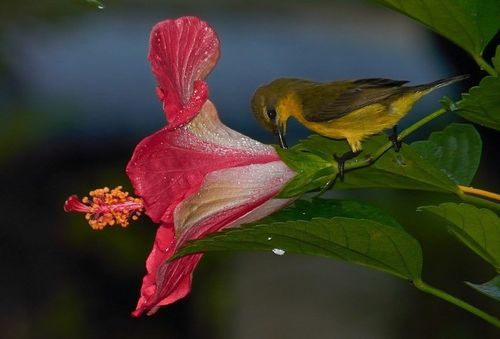The origin of the hibiscus is not known but Keng (1990) believes that it probably originates from China. The pollinating agent is reported to be the hummingbird. In the tropics the hummingbird is represented by the sunbird. But sunbirds are not adapted for hibiscus pollination.
BK Lim photographed an Olive-Backed Sunbird (Cinnyris jugularis) as it was in the process of robbing a hibiscus flower (Hibiscus rosa-sinensis) of its nectar in an unconventional way.
To get at the nectar, the sunbird probes the base of the flower rather than pokes its head into the corolla “tube” and in the process does not help in the pollination process.
An earlier post shows a Brown-throated Sunbird (Anthreptes malacensis) similarly robbing nectar from another hibiscus flower.
Image by BK Lim.
Reference:
Keng, H. (1990). The concise flora of Singapore: Gymnosperms and dicotyledons Singapore University Press. 222 pp.
This post is a cooperative effort between www.naturepixels.org and BESG to bring the study of bird behaviour through photography to a wider audience.










9 Responses
This morning I observed a sunbird collecting nectar from the base of a hibiscus flower. After the bird left, I plucked and carefully examined the flower to see whether there were punctured holes on the flower. To my surprise, I found none. Then I tried to find out how hard to puncture a hole at the base of the petal by using the opened end of a paper clip. I used quite a strength to succeed it. It might be easier for the sunbird because its bill is needle sharp. I hope to find a hibiscus flower with the punctured holes done by a sunbird.
It can be that the sunbird slipped its bill between the base of the petals to get at the nectar. Should you manage to locate a puncture mark, please take a photograph do let us know.
Your reply noted and thanks. More observations definitely needed to find the answer.
Just to add to my post above. The sunbird was an olive-backed and my location is Penang, Malaysia.
Just past noon, the weather was sunny outside and I was very lucky to spot five olive-backed sunbirds in the hibiscus garden. I managed to observe them as near as 2 metres away. I was convinced that they never punctured the base of the petals for the nectar but instead they simply inserted their bills between the sepal and the base of the petal and sucked the nectar. They took 1-2 seconds for the job done in each flower. I feel very nice!
Great observation. Now we know.
In Kerala, India, sunbirds are very common on the traditional red Hibiscus rosa-sinensis variety that is generally grown in house holds for offering the flowers to Hindu Gods during pujas (worship). But nowadays the traditional variety has been replaced with attractive looking new hybrids that do not attract sunbirds. Are the nectaries lost during hybridization? Does a similar situation exist in Singapore and Malaysia?
I do not think nectaries can be lost through hybridisation, maybe through mutation – but I stand corrected. With more attractive varieties/species being available, I am sure the traditional varieties/species will be slowly replaced.